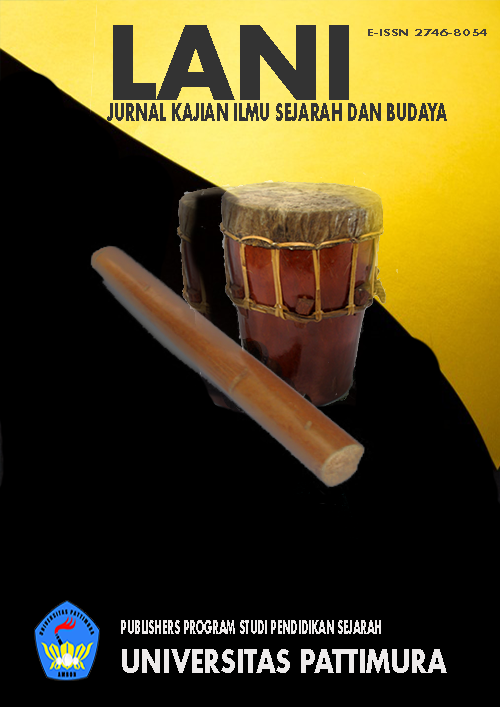Tradisi Wela-Wela Dalam Perkawinan Di Desa Air Nanang Kecamatan Siritaun Wida Timur Kabupaten Seram Bagian Timur
The Wela-Wela Tradition in Marriage in Air Nanang Village, Siritaun Wida Timur District, East Seram Regency
Abstract
The Wela-wela tradition is a deeply rooted cultural practice that plays a significant role in the wedding ceremonies of certain Indonesian communities. This tradition is rich in symbolism and is carried out in three distinct phases, each holding its own cultural significance. The process begins with a deliberation or consultation among the families involved, highlighting the communal aspect of the tradition. The first phase of the Wela-wela occurs when the groom arrives at the bride's house, specifically in front of the sabuah (a ceremonial tent), marking the initial formal meeting between the two families. This moment is crucial as it symbolizes the groom's respectful approach and request for the bride's hand in marriage. The second phase takes place at the front door of the bride's house, where the groom is met with another Wela-wela, representing a more intimate acceptance by the bride's family. This step underscores the importance of familial consent and the gradual transition of the bride from her family to the groom. The final Wela-wela occurs when the groom comes to escort the bride to their new home, symbolizing the completion of the union. This tradition not only serves to honor the bride and her family but also adds a festive and respectful atmosphere to the wedding ceremony. Through these rituals, the Wela-wela tradition reinforces the values of respect, family unity, and cultural heritage, making it a vital component of the wedding process.
Downloads
References
Benedict, R. (1934). Patterns of culture. Houghton Mifflin.
Bourdieu, P. (1984). Distinction: A social critique of the judgement of taste. Harvard University Press.
Durkheim, E. (1893). The division of labor in society. Free Press.
Eriksen, T. H. (2001). Small places, large issues: An introduction to social and cultural anthropology. Pluto Press.
Geertz, C. (1963). Peddlers and princes: Social change and economic modernization in two Indonesian towns. University of Chicago Press.
Geertz, C. (1973). The interpretation of cultures: Selected essays. Basic Books.
Herskovits, M. J. (1948). Man and his works: The science of cultural anthropology. Knopf.
Kluckhohn, C. (1951). Values and value-orientations in the theory of action: An exploration in definition and classification. In T. Parsons & E. Shils (Eds.), Toward a general theory of action (pp. 388-433). Harvard University Press.
Koentjaraningrat. (1974). Kebudayaan, mentalitas dan pembangunan. Gramedia.
Levi-Strauss, C. (1966). The savage mind. University of Chicago Press.
Linton, R. (1945). The cultural background of personality. Appleton-Century-Crofts.
Malinowski, B. (1922). Argonauts of the Western Pacific: An account of native enterprise and adventure in the Archipelagoes of Melanesian New Guinea. Routledge & Kegan Paul Ltd.
Sahlins, M. (1976). Culture and practical reason. University of Chicago Press.
Schwartz, S. H. (1992). Universals in the content and structure of values: Theoretical advances and empirical tests in 20 countries. Advances in Experimental Social Psychology, 25, 1-65.
Soemardjan, S., & Soemardi, S. (1964). Setangkai bunga sosiologi. Lembaga Penerbit Fakultas Ekonomi Universitas Indonesia.
Spradley, J. P. (1979). The ethnographic interview. Holt, Rinehart and Winston.
Tylor, E. B. (1871). Primitive culture: Researches into the development of mythology, philosophy, religion, language, art, and custom. John Murray.
Turner, V. (1967). The forest of symbols: Aspects of Ndembu ritual. Cornell University Press.
Copyright (c) 2022 Vifi L Rumbara, Nur Aida Kubangun, Rina Pusparani

This work is licensed under a Creative Commons Attribution-ShareAlike 4.0 International License.








